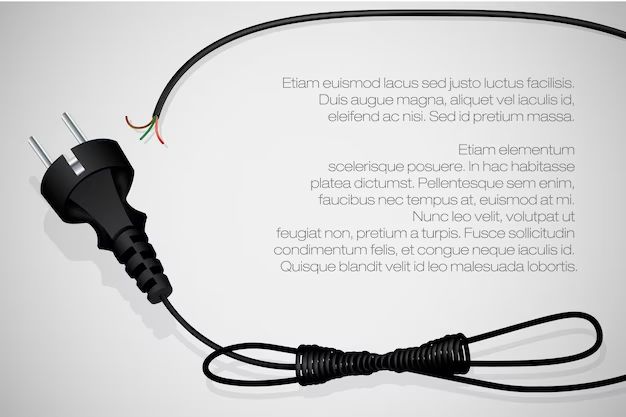Quick answer: Generally, it is not recommended to pass extension cords through walls or ceilings. This poses potential fire and shock hazards. If you need to supply power on the other side of a wall, it is better to have a qualified electrician install a new outlet or wire a permanent connection through the wall.
Page Contents
Safety Concerns with Extension Cords and Walls
There are a few key reasons why running an extension cord through a wall is not advisable:
- Fire hazard – Having an extension cord behind a wall where it is hidden and not readily accessible increases the fire risk if the cord is damaged or draws too much power. This can lead to overheating and fires.
- Shock hazard – If there is damage to the extension cord’s insulation while inside the wall, this could expose live wires and increase the risk of electric shock to anyone near the damaged section.
- Not designed for permanent installation – Extension cords are intended for temporary use and have safety features to reflect this. Installing one inside a wall bypasses those safety features.
- Against electrical code – The National Electrical Code prohibits the use of extension cords as a substitute for permanent wiring. Running one through a wall typically violates this code.
Extension cords have their place for providing power to devices and appliances temporarily, but they are not intended as a permanent solution inside of walls, floors, or ceilings.
Alternatives to Safely Wire Through Walls
If you need to have a power source on the other side of a wall from an existing outlet, there are safer options to consider:
- Hire an electrician to add a new outlet – This is the best way to ensure the job is done properly and safely. They can fish wiring through the wall cavity and install a permanent, mounted outlet.
- Use electrical conduit – You can run wiring through electrical conduit which protects the wires and can be securely mounted to the inside of the wall framing.
- Install a junction box – A Blank electrical box can be installed on each side of the wall and wiring fished through the hollow wall cavity. The boxes hide connections and expose just the outlets.
- Use a low voltage connection – For some devices, low voltage wiring may be an option, such as HDMI, speaker, or ethernet cables. These can safely be passed through walls if properly installed.
Consulting with an electrician is the best way to identify the ideal permanent solution for your unique situation and ensure it is done safely and to code.
Key Electrical Code Requirements
If you do want to wire through a wall permanently, either by yourself or with professional help, there are some key electrical code requirements to keep in mind:
- Use approved wiring – Such as NM, UF, or SER cables suitable for permanent installation.
- Use propersupports – Cables and wires through holes must be protected from damage. Avoid staples
- Mind fire separations – Cables passing through firewalls require special caulking andprotection.
- Follow size rules – Oversized holes around wires can allow fire to spread. Keepholes appropriately sized.
- Separate safely – Maintain proper separation from gas lines, flues, and other non-electrical components.
- Mind insulation contact – Wiring must avoid direct contact with insulation which can overheat.
Additionally, rules exist regarding junction boxes, securing cables properly, and avoiding sharp corners or bends. Taking the time to understand relevant building codes for your area is important.
Installation Process If Running a Cord Through Walls
If you do decide to go ahead with running an extension cord through a wall in spite of the risks, here are some key steps in the process:
- Turn off power at the breaker – Working with the power off reduces risk of shock.
- Choose an appropriate path – Avoid insulation, wiring, pipes when deciding where to pass the cord.
- Cut access point openings – Use drywall saw to cut openings on each side of wall for access.
- Drill passage holes – Drill holes centered in each opening at the desired path height.
- Protect cord ends – Wrap ends with electrical tape to avoid damaging while pulling through.
- Pull cord through – Use wire puller or fish tape to pass cord through the drilled passage holes.
- Seal openings – Seal around cord with fireblock caulk to restore fire separation.
- Patch and finish – Patch drywall openings with compound for a seamless look.
- Test circuit – Restore power and test that the outlet functions properly.
Safety gear like eye protection, masks, and gloves should be used. Wall materials also impact the cutting and patching complexity. Take care not to kink or excessively bend the cord when pulling through.
Risks and Dangers
Even if proper precautions are taken, running an extension cord through walls comes with inherent risks:
- Fire hazard from overheating if too much power is drawn through the cord
- Electric shock risk if damage occurs to the cord while inside the wall
- Short circuit potential if insulation is pierced by a screw or nail
- Damage to the cord if stapled or bent too much when installed
- Voiding homeowners insurance policies and fire coverage
Permanent solutions installed by qualified electricians are recommended over extension cords in walls whenever possible.
Conclusion
While it is physically possible to run an extension cord through a wall to another room, doing so poses substantial safety hazards and is not considered safe or good practice. Violating building codes and bypassing safety features makes using an extension cord in this way a major fire and shock risk. Hiring a professional electrician to install a new outlet or permanent wiring through the wall cavity is the recommended approach in nearly all cases, and follows proper building codes.
